A stove with a water circuit for heating a house: features of stove heating + choosing the optimal option
Firewood and coal remain in many regions the most affordable types of fuel used to heat private cottages. However, stove heating is chosen not only because of the low cost and availability of energy, but also because of the low cost of its installation.
Moreover, in addition to many advantages, a stove with a water circuit for heating a house also has a lot of disadvantages. This option is not always optimal. Let's try to understand the nuances of such a heating system.
The content of the article:
Features of stove-based heating
Stove heating is the norm for Russian villages, the reliability and practicality of which has been proven for centuries. And today, many village houses have ovens with a stove for cooking food and a hearth for baking bread.
Some of them are equipped with a water circuit for the heating system, while others are not. But rural homeowners are in no hurry to throw them away and replace them with modern boilers. A more trouble-free and problem-free heating method has not yet been invented.

The following is burned as fuel in such village stoves:
- coal;
- peat;
- firewood;
- briquettes (eurowood).
There is no fundamental difference between these types of fuel from the point of view of the design of the stove inside and the wiring of the water heating system in a private house. Some of them give off more heat, while others take longer to burn out. But the design of the firebox and the layout of pipes with coolant in the rooms are the same in all cases.
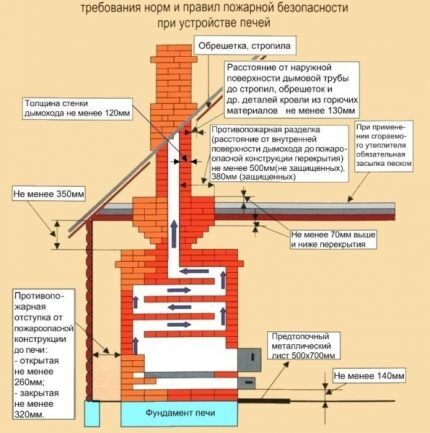
Among the advantages of stove heating are:
- no dependence on the availability of electricity in the network;
- relatively low cost of installing a heating system;
- low cost of solid fuel and the possibility of using different types of fuel;
- extreme ease of operation;
- long-term heat transfer (for brick structures);
- versatility - suitable for heating and cooking food at the same time.
If a private house cannot be connected to main gas, then a wood stove will be the best choice for heating it.
The only exception is when coal or firewood is not available in a particular area. But this option in Russia is the exception rather than the norm.

Also among the disadvantages of stove heating should be mentioned:
- long warm-up of the system before heat transfer begins;
- loss of useful space in the house due to the massiveness of the stove;
- heavy weight of the brick stove structure;
- low efficiency due to the loss of a significant amount of heat into the pipe;
- high fire hazard if used incorrectly.
A brick heating and cooking stove for a private house with water heating, depending on the design and number of rows, can weigh from 1.5 to 10 tons. Plus the weight of the pipe is added here.
A foundation for such a mass requires a powerful and expensive foundation, which can also be called a disadvantage of the heating systems under consideration.
Stove water heating device
The furnace for the heating system in question should ideally be calculated and built at the same time as the house. If a residential building has already been erected, then it will be difficult to install a brick stove structure in it. And often this turns out to be completely impossible due to the need to build a solid foundation and rebuild the rafter system.
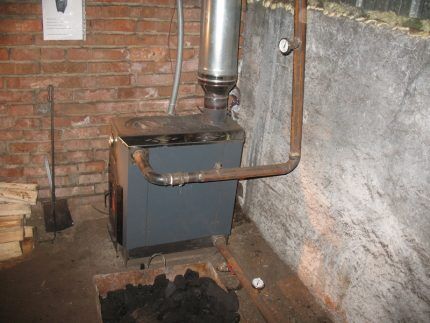
Stove-based water heating consists of:
- the stove itself (metal or brick);
- a heat exchanger inside or around the stove firebox, as well as in the form of a coil around the chimney;
- a circuit with coolant distributed throughout the house and an expansion tank in the attic.
Also, in some cases, this heating system is supplemented with a circulation pump and a hydraulic accumulator. However, this extended option is used extremely rarely, since it requires an uninterrupted power supply and leads to an increase in the cost of the entire circuit.
And the main advantage of water stove heating is the low cost of the device. It is not worth supplementing it with expensive and breakage-prone elements.
Water circulation diagram in the circuit
The water heating system in houses is built with natural (gravitational) or forced circulation of the coolant.If it is made on the basis of a wood stove, then it is best to give preference to the first option.
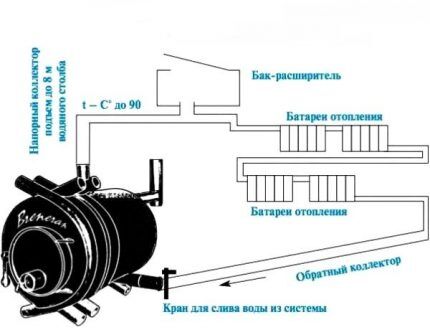
It is recommended to install water stove heating only in one-story houses with an area of up to 150 m2. In this case, it can be made gravitational without additional pumps.
If you need to heat a cottage of a couple or more floors, then it is better to do this using a more powerful boiler. The furnace for such buildings will have to be built simply huge, which is expensive to implement. Yes, and you will have to put considerable amounts of fuel into it each time. But doing this is highly discouraged due to the increased risk of fires.
A classic stove heating system with natural water circulation consists of:
- heat exchanger as part of the stove;
- metal pipeline circuit;
- radiators (usually replaced with thick pipes in rooms);
- expansion tank.
If you decide to do water heating in a country house yourself, then it is better to design it according to this scheme. Installation and calculation of this option is easier than with forced water movement.
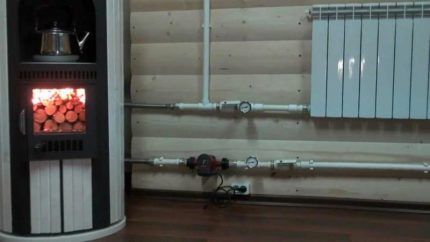
If the boiler is automated and constantly heats water as needed, then the wood-burning stove is heated once or twice a day. It is at these moments that the coolant in the furnace firebox heats up to release heat into the rooms. Afterwards, driving it with a pump through the pipes of the circuit is pointless. Nothing will heat the water in a cold firebox anyway.
When choosing a wood or coal stove, owners of private houses usually expect to receive an autonomous heating system. If you install pumping equipment in it that requires power from the electrical network for operation, then it will be difficult to talk about autonomy.
Oven - brick or metal
A brick oven takes longer to heat up, but it also takes longer to transfer heat to the space around it. The steel counterpart, on the contrary, heats up quickly and cools down just as quickly after the fuel burns out. This problem is partially solved due to the presence of large volumes of coolant in the water circuit.
However, the more water that has to be stored in the system, the more expensive it becomes in terms of materials.

A steel furnace for water heating with a power of 5–15 kW - without fuel and water it is a structure weighing 100–300 kg. Such a potbelly stove can be safely placed on reinforced logs. Stove foundations need to be poured when the stove weighs more than 700–800 kg. Now, if it is brick, then you definitely can’t do without concrete work.
Compared to a metal stove, a brick stove weighs more, costs more and is more difficult to install. However, it has higher efficiency and less risk of freezing the circuit with pipe rupture due to the formation of ice inside. If you decide to do everything completely for yourself and permanent residence, then it is recommended to choose the brick option.
Pipes - stainless steel or metal-plastic
If the heating system is built on the basis of a hot water boiler, then it can be piped not only with steel pipes, but also with metal-plastic and polypropylene pipes.However, if the water is heated by a wood-burning stove, then the circuit with the coolant from it should be created only from stainless steel.
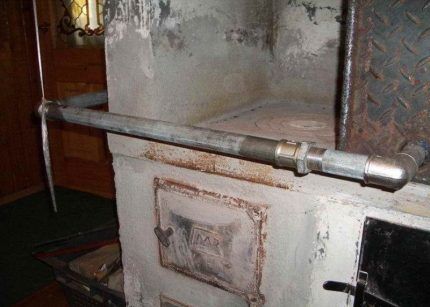
Metal-plastic is designed to work with coolant heated to 90–95 °C. For a short time it can withstand heating up to 110–120 °C. At the same time, the automation of boilers and boilers initially does not allow the water to warm up to such degrees. For heated floors it heats up to 30–45 °C, and for radiators up to 60–65 °C.
However, in the case of a wood-burning stove, temperatures under a hundred are not only possible, but far from uncommon. It is not recommended to take risks and play Russian roulette by piping this stove with metal-plastic pipes. It is best to give preference to more reliable stainless steel.
In addition, the pipes coming out of the furnace from the coil for connecting the circuit pipes will definitely heat up to very high temperatures. They are separated from an open fire by less than half a meter. It is dangerous to connect any plastic pipes to them due to the risk of them melting.
Heat dissipation - radiators or register
Heat is supplied from the stove to the heating circuit in portions of several hours, while wood or coal is burning in the firebox. If there is not enough water in the heating system, the house will quickly dry out. Therefore, in villages, such heating is usually made from thick steel pipes, and not on the basis of radiators more familiar to city dwellers. The heating register for wood burning stoves is simply perfect.
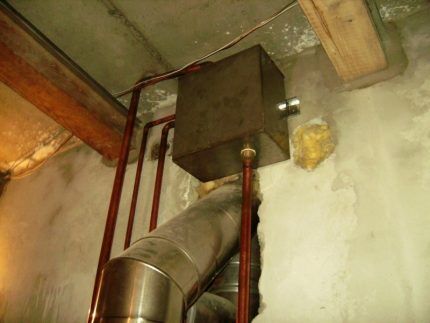
A stainless steel pipe with a diameter of 80–120 mm laid throughout the house is a heating register, consisting of a supply from the stove and a return to it. In the room farthest from the firebox, these lines are connected together, and in the remaining rooms they are laid in the form of two pipelines along the outer walls.
The register does not look as aesthetically pleasing as the radiator. But the first option is much cheaper and easier to make yourself than the second. To implement it, you just need to have experience in handling a welding machine.
The heat transfer area for such a circuit is calculated by multiplying the PI number by the diameter and length of the pipe. Plus, in the calculations it is necessary to take into account the thermal pressure in the supply and return, as well as the vertical distance between the pipelines.
However, often such calculations are not made, but a pipe with a diameter of 80–100 mm is taken and laid around the perimeter of the entire residential building with a loop in the back room. In this case, heat transfer is adjusted “by eye” and experimentally as a result of adding a particular volume of fuel to the firebox.
It’s not for nothing that register circuits coupled with water furnaces are so common. You don’t even need to calculate them, just take a suitable pipe and weld it together.
Selecting a heat exchanger for the furnace
The heat exchanger in the stove can be made of copper, steel or cast iron. It is better to immediately exclude the copper option due to the high price. Soldering such a device yourself is extremely problematic.
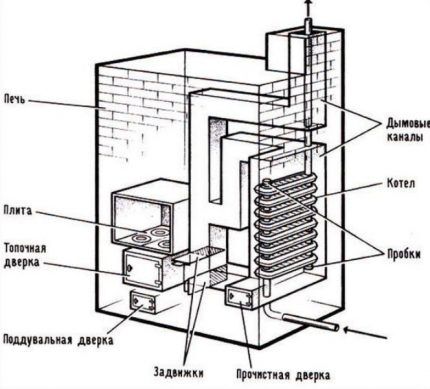
Cast iron is superior to steel in terms of technical parameters. However, making a heat exchanger for a wood-burning stove out of it yourself seems problematic. You can only take an old battery for this. But here we must take into account that the seal between its sections will burn out in the firebox. And this is a direct path to loss of tightness and water escaping into the combustion chamber.
If it is decided to make the heat exchanger from a cast iron battery, then it is best to take the MS-110-300 or MS-90-300 models for this. They are small and will easily fit in the firebox. Their heating surface area for each rib will be about 0.14–0.16 m2.
Based on these numbers, you can estimate how many sections will be required for a particular circuit. For every 10 square meters of house area you need 1 kW, which will be approximately equal to 0.1 m2 heating area of a cast iron heat exchanger.
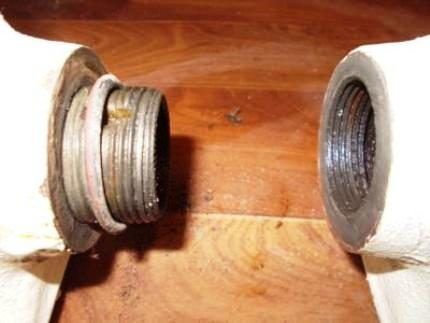
Another point about using a cast iron battery as a heat exchanger is the difficulty of cleaning it from soot from inside the firebox. From time to time the combustion chamber needs to be cleaned, and the raised ribs of the cast iron will greatly interfere with this.
The most optimal option for a heat exchanger is steel in the form of:
- a coil of several tubes;
- sheet steel shirts.
They are made from low-carbon steel St10...St20 with a thickness of 4–5 mm. If you take tubes, then with a diameter of 30–50 mm.
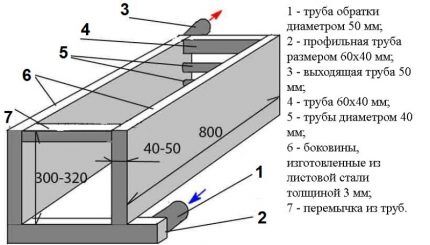
The tubular version is more efficient in terms of heat transfer, but it is also more labor-intensive to manufacture.
To calculate the heat exchanger, use the formula:
Qy=K*(Tcp-Tk)
Where:
- K – heat transfer coefficient of the material (for low-carbon steels 15–20 is taken, and for gray cast iron – 50);
- Tcp – average temperature of the heating medium in the furnace (Tmax+Tmin)/2;
- Tk – average coolant temperature (Tsupply + Treturn)/2.
If wood is burned in the stove, then Tcp=(700+300)/2=500 °C and Tk=(80+60)/2=70 °C. As a result, Qy=15*(500-70)=6450 kcal/hour. That is, per square meter of the heat exchanger surface facing the fire will be approximately 7.5 kW/hour.
For coal, the calculations are as follows: Tcp=(1000+600)/2=800 °C and Tk=70 °C. Qy=15*(800-70)=10,950 kcal/hour=12,734 W/hour. A square meter of heat exchanger surface will give about 12.7 kW/hour.
Next, we divide the power required to heat a particular house by the calculated figure, depending on the plans for using a particular type of fuel.
For example, for a cottage 150 m2 you need about 15 kW. If it is heated with wood, then a heat exchanger with a heat exchange area of 15/7.5 = 2 m will be required2. This is the surface that faces the flame and heats up.
If a tubular coil is selected, then its length is calculated by the formula:
S=2*3.14*D*L
Where:
S – design area;
D – tube diameter;
L - required length.
The parameters of a steel sheet jacket are even easier to calculate; it usually consists of two rectangles on the sides of the combustion chamber.
Choosing the best option
It will be difficult to install a massive brick stove in an already built house. In this case, water heating is best organized on the basis of a metal potbelly stove, which can be placed on a reinforced wooden floor without pouring the foundation.
However, if it is possible to make the foundation as it should be, then preference should be given to a more reliable brick stove structure.
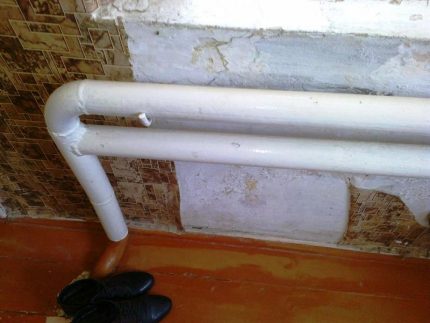
Installing a circulation pump and/or accumulator in the heating circuit in question is a waste of money and zero additional benefit. They will only complicate the installation of the system. And if the lights go out, these devices will create problems. Whereas the heating option without them will continue to calmly heat the house if there are problems in the electrical network.
Conclusions and useful video on the topic
Choosing the shape of a heat exchanger for a wood stove:
Review of a brick stove for water heating in a cottage:
Construction of a brick heating and cooking stove with analysis of the design order:
It is difficult to call water heating based on a wood stove ideal and highly efficient. But this option for heating private houses is the most reliable, as well as cheap and easy to implement. You just don’t need to supplement such a circuit with a circulation pump and automation. They operate from the mains and make the entire system non-autonomous, eliminating one of its main advantages.




If I have a two-story 6x8 house, is it possible to make a furnace with a water circuit, but without a circulation pump? It is clear that it is better with a pump - more uniform heating of the batteries, etc., but I would like to save money.
Yes, this is quite possible. I have had such a system at my dacha for more than five years. Stove, expansion tank in the attic, four batteries (two on the first, two on the second floor), single-pipe system, metal-plastic, filled with antifreeze. If you have a house, then you can even fill it with water, it will be even better. Both in terms of fluidity and heat capacity. So it’s quite possible to do without a pump.
They forgot to add that, as a rule, a hot water boiler is also built into such a furnace. So it solves two problems at once.
Hello. I have a question about the stove. Frame dacha, which stove to choose, there are many options and reviews, both positive and negative.
There was only one question: what type of fuel (type of coal) is better to use if the stove is equipped with a hot water boiler??
A lot of unnecessary water.
Why not install a bypass with the pump, the autonomy will not go away, if there is a power outage, we turn off the pump and run it in direct flow... especially since these pumps are inexpensive and consume up to 100 W with a column of up to 6 m (if someone has a 2-floor) with several pumping modes. Plus there is an uninterruptible power supply, a 220 V power bank - but this will be expensive. So let's go with the bypass!